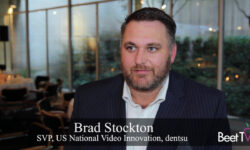When you spend £3 billion ($3.6 billion) a year on marketing, you want it underpinned by solid data.
Drinks maker Diageo upped its global marketing spend by 5.6% last year, including a record advertising and promotion spend of £545 million.
In this video interview with Beet.TV, Patrick Teske, Director, Global Media Operations, Diageo, explains what he wants from the digital ad economy.
Addressing the Challenges in Measurement
According to Teske, the biggest challenge that marketers face is the “timeliness of data and access”.
He is looking for “timeliness, quality and working through getting to insights that we can apply within campaigns faster”.
Interviewed by Jon Watts for Beet.TV, Teske emphasizes the need to integrate not just viewability and view-through rates, but also modelling actual attention. Teske thinks that orchestrating all of this noise to get to the right triggers can help drive better outcomes.
Increased Ad Spend
Diageo brands include Guinness and Johnnie Walkers.
In its just-published annual report for the year ending June 2023, the company claims a 22% sales return on advertising and promotion investment.
All its global markets increased spend versus last year, as the company aims to connect with consumers in many countries facing cost-of-living increases.
https://twitter.com/Diageo_NA/status/1704580501510525310
The Role of First Party Data
The growing interest in first party data is a crucial factor in evolving marketing analytics and measuring capabilities.
However, Teske first-party is not enough. He proposes focusing on both consumer and commercial data.
“When you’re a CPG advertiser, a lot of the focus tends to be on first, ‘How can we flex the readily available assets with commercial data?’ And then when you look at from a consumer data perspective, it’s about growing that first party data availability.”
Looking Ahead: Innovations in Measurement
When asked about innovations in measurement, Teske brings the focus back to bridging the gap between data availability and speed. He wants to see “doing things faster”.
“How do you create more parity within video reporting so that it acts more like standard digital reporting?,” he wonders.
“How do you work with the agency teams to get to cleansing and QA faster?”





























